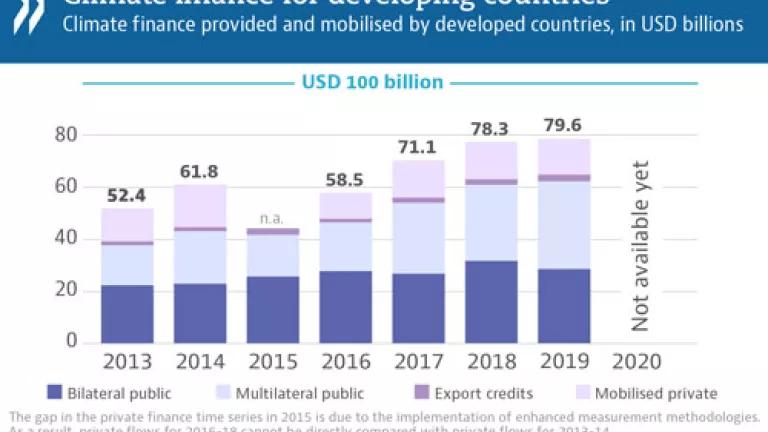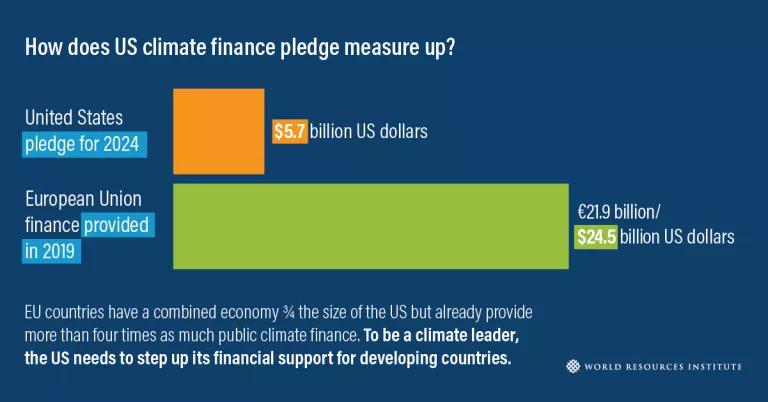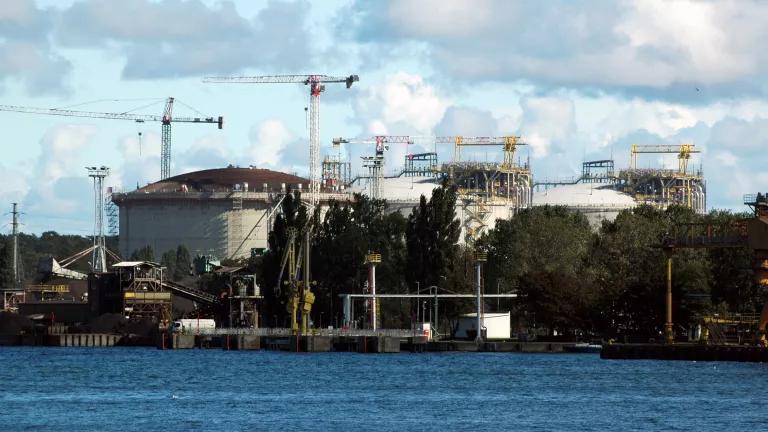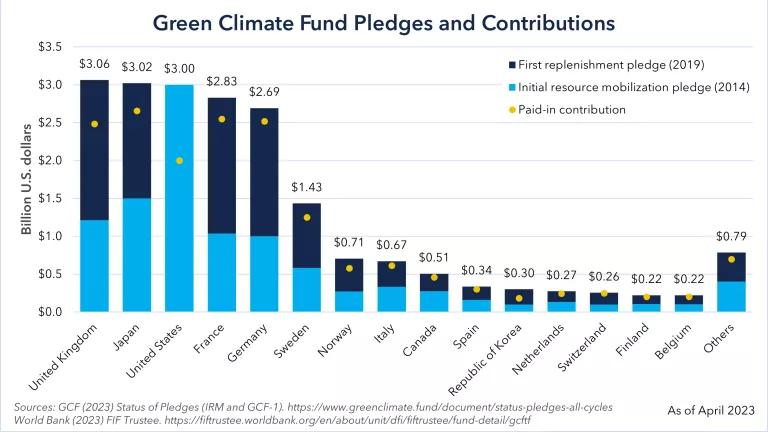US Commits to More International Climate Finance
The U.S. needs to urgently mobilize more international climate finance if we are going to have a chance of a successful climate summit in Glasgow this November, and any chance of keeping 1.5°C alive.

One of the key stumbling blocks to greater international climate action is the lack of finance to assist developing countries in further reducing emissions and addressing the impacts of climate change. Developed countries have failed to mobilize the $100 billion per year that they promised by 2020. The U.S. recognized its need to step-up with President Biden committing at the UN General Assembly to increase its bilateral climate finance to at least $11.4 billion per year by 2024. Investments on that scale are in America’s interest to avoid the world destabilizing effect of climate change and help to unleash even greater climate action around the world.
As NRDC’s CEO and President Manish Bapna said:
“The Biden administration is taking is a significant step forward in boosting support for countries that are both suffering the most from climate change and have the least financial resources to combat it. But it will not be enough if we stop here. Now Congress must fully enact President Biden’s pledge to help developing countries cut climate pollution and protect against its impacts, starting with funding this year's contribution at $3.3 billion. It’s both a critical part of the solution to overcoming this global crisis and a moral obligation.”
In 2009 and again in 2015, developed countries committed to “a goal of mobilizing jointly $100 billion per year by 2020 to address the needs of developing countries”. This was a critical part of the overall political package that helped secure the Paris Agreement, and it is a necessary component of the strategy to combat the climate crisis.
Developed countries have fallen short on the climate finance goal
Developed countries have fallen short of the goal to mobilize $100 billion per year by 2020 (see figure). In 2019, developed countries mobilized $79.6 billion in international climate finance, according to the Organization for Economic Cooperation and Development (OECD). While this was a slight increase from the 2018 amount—a $1.3 billion increase—there is no expectation that the 2020 values will reach the $100 billion goal. Others have pointed out that how this finance has been mobilized and the total quantity may be less than meets the eye. So, developed countries are expected to be around $20 billion short of the overall pledge.
At the same time, there is a need to significantly increase the amount of funding going to support adaptation. While adaptation finance grew in 2019, according to the OECD, it only accounts for around 25 percent of this total financing which is too low given the scale of the needs in the most vulnerable countries and communities. A number of leaders including the UN Secretary-General have been calling for a 50-50 split between the funding to support developing countries in adapting to the impacts of climate change and the resources to help them reduce emissions. Denmark, Sweden, and the Netherlands have committed to fund adaptation and mitigation equally, and similar commitments are needed from all donor countries including the U.S.
U.S. needs to do more—mobilize at least $12 billion per year by 2024
In April, President Biden announced a commitment to increase U.S. bilateral climate finance to $5.7 billion per year by 2020—this would roughly double the amount that the Obama administration was delivering. The U.S. also committed to increase its funding for adaptation to $1.5 billion per year—tripling the amount from the end of the Obama administration.
The U.S. needs to help mobilize more bilateral international climate finance. The European Union—with an economy smaller than the U.S.—currently contributes around $25 billion per year in international climate finance (see figure before this new announcement). Given the size of the U.S. economy and its historical contribution to the climate crisis, the U.S. needs to deliver an even larger amount of bilateral international climate finance than its original promise.

Leading aid, development, faith-based, and environmental groups today are urging the Biden Administration to commit raise U.S. international climate finance to $12 billion per year by 2024 as a part of the effort to support the Paris agreement on climate change and “keep 1.5°C alive.” As Susan Gunn, director of the Maryknoll Office for Global Concerns, said: “These climate-fueled disasters come with costs—economic and existential—that fall hardest on God’s creation and on communities and nations least able to respond. As the largest economy and largest historical emitter, the United States can and must do more to be part of the solution. A $12 Billion commitment to climate finance by 2024 would be a good down payment.”
President Biden’s announcement at the UN General Assembly is a significant step forward towards this increased finance mobilization. As President Biden said:
“We also have to support the countries and people that will be hit the hardest and that have the fewest resources to help them adapt. In April, I announced the United States will double our public international financing to help developing nations tackle the climate crisis. And today, I’m proud to announce that we’ll work with the Congress to double that number again, including for adaptation efforts. This will make the United States a leader in public climate finance, and with our added support together with increased private capital and other donors we will be able to meet the goal of mobilizing $100 billion dollars to support climate action in developing nations”.
As a step towards this scaled-up finance, more than 85 leading faith-based, development, environmental, and business groups submitted a letter urging congressional appropriators to provide at least $3.3 billion in U.S. support this year for international programs addressing the climate crisis. Congress needs to deliver.
The U.S. needs to urgently mobilize more international climate finance if we are going to have a chance of a successful climate summit in Glasgow this November, and any chance of keeping 1.5°C alive.
Mobilizing greater climate finance is in America’s interest
This increased finance is key to meeting America’s objectives. With larger investments, developing countries can speed-up the delivery of the necessary global emissions cuts we need this decade. This will help lead to less damages from climate change. America can protect itself and the world from more devastation by helping to reduce emissions that don’t occur within U.S. borders. Less climate pollution from around the world means hundreds of billions of dollars less in damages from climate change. That is a return on investment that easily pays for itself.
These investments also create opportunities for American companies to tap into the growing zero emissions sectors that are poised for rapid growth in the decades ahead. There is a more than $23 trillion global market for climate-smart investments in emerging markets. America can tap into this growing demand by leading the deployment of these technologies and goods at home, and through strategic investments abroad. Trillions of new opportunities can be mobilized with scaled-up finance today.
The most vulnerable and poorest in the world have contributed the least to the climate crisis. Yet they are first and most affected by the devastating impacts of climate change. Scaled-up support to build more resilience to the climate crisis helps to lessen the burden on individuals and communities that have contributed the least to cause the problem in the first place. Given the scale of the impacts that are already being felt, there is an urgent need for the U.S. and others to significantly increase their financing for adaptation and resilience.
By committing to mobilize $11.4 billion per year in bilateral climate finance by 2024, the U.S. can more forcefully persuade other countries to increase their climate actions before 2030. Showing that the U.S. will help deliver the $100 billion per year climate finance goal will build the kind of trust that is necessary to ensure that climate summit in Glasgow is a success in keeping open the possibility of holding temperatures to less than 1.5°C. And it will help the most vulnerable amongst us to cope with the consequences of the climate change caused by the world’s inability to act aggressive enough over the past decades.
Now is the time to mobilize.




